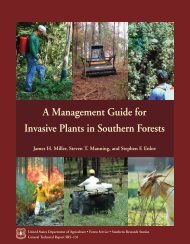Introduction - Stored Grain Pest Management Pest Management for ...
Introduction - Stored Grain Pest Management Pest Management for ...
Introduction - Stored Grain Pest Management Pest Management for ...
Create successful ePaper yourself
Turn your PDF publications into a flip-book with our unique Google optimized e-Paper software.
classes and modes of action. Of particular concern are the organophosphate andpyrethroid protectants.The same fumigant, phosphine, is used with no rotation with other chemical classes.Methyl bromide is to be phased out entirely in 2005, leaving phosphine as the onlyregistered fumigant <strong>for</strong> application directly to stored wheat.Resistance to phosphine can occur in locations where it is used frequently, but thus farthere have been no real control failures in Montana. Investigation of unsuccessfulfumigation has shown that improper application has been the cause of the reducedefficacy in every circumstance scrutinized. However, proper use of phosphine isessential to prevent resistance development, including correct bin sealing and dosage tomaintain phosphine concentration at high levels <strong>for</strong> a sufficient amount of time. Asstated above, these are now label requirements, and will ensure that improper applicationdoes not speed the development of resistance through exposure to a less than optimalconcentration, or by shortening of the exposure interval.Consumer Education Issues<strong>Pest</strong>icide residues are an ever-growing concern to consumers, and many of the grainprotectants can be detected in the final milled product. However, phosphine fumigantdoes not leave any residues once the grain is ventilated.Insect fragments and parts, rodent and bird droppings and hairs are all undesirablecomponents in foodstuffs. The standard <strong>for</strong> the acceptable amount of insect fragmentsand/or animal droppings in a milled product is regulated by the Food and DrugAdministration (FDA). Flour mills will not accept grain with live insects or animaldroppings, and strive to strictly limit the amount of insect fragments. Millers also notethat these fragments are not just of pest insects, but of beneficial (e.g., predators,parasites) insects as well, thus limiting their use.Consumers are largely unaware of the balance between the use of pesticides and thosestandards that pertain to fragment and animal dropping in grain. Perhaps a criticaleducation issue is to stress that good storage practices limit the use of pesticides toprevent contamination of foodstuff by either the pesticide residue or unacceptable levelsof the end products from infestation.As a related issue, the Food and Agriculture Organization and the World HealthOrganization have established the Codex Alimentarius, which sets international residuelimits. Insect-infested grain is not acceptable, and only those pesticides that are on theCodex can be exported unless accepted by the receiving country. Given that most ofMontana’s wheat is exported, this further limits insecticides that can be used on storedgrain. For example, the product Storicide® contains cyfluthrin as one of its activeingredients, but since there is no Codex Maximum Residue Limit (MRL) <strong>for</strong> thischemical, wheat destined <strong>for</strong> export cannot be treated with the product.
















